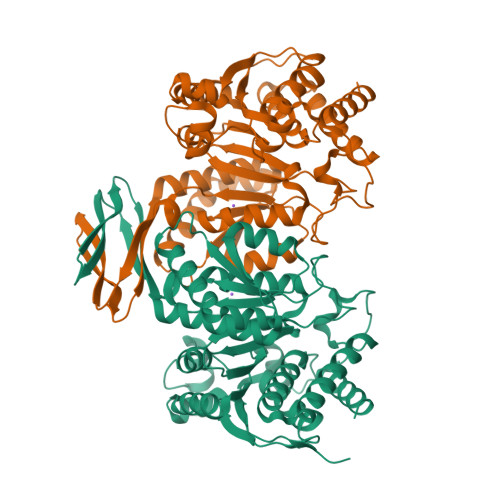The crystal structure of a hyperthermostable subfamily II isocitrate dehydrogenase from Thermotoga maritima.
Karlstrom, M., Steen, I.H., Madern, D., Fedoy, A.E., Birkeland, N.K., Ladenstein, R.(2006) FEBS J 273: 2851-2868
- PubMed: 16759231
- DOI: https://doi.org/10.1111/j.1742-4658.2006.05298.x
- Primary Citation of Related Structures:
1ZOR - PubMed Abstract:
Isocitrate dehydrogenase (IDH) from the hyperthermophile Thermotoga maritima (TmIDH) catalyses NADP+- and metal-dependent oxidative decarboxylation of isocitrate to alpha-ketoglutarate. It belongs to the beta-decarboxylating dehydrogenase family and is the only hyperthermostable IDH identified within subfamily II. Furthermore, it is the only IDH that has been characterized as both dimeric and tetrameric in solution. We solved the crystal structure of the dimeric apo form of TmIDH at 2.2 A. The R-factor of the refined model was 18.5% (R(free) 22.4%). The conformation of the TmIDH structure was open and showed a domain rotation of 25-30 degrees compared with closed IDHs. The separate domains were found to be homologous to those of the mesophilic mammalian IDHs of subfamily II and were subjected to a comparative analysis in order to find differences that could explain the large difference in thermostability. Mutational studies revealed that stabilization of the N- and C-termini via long-range electrostatic interactions were important for the higher thermostability of TmIDH. Moreover, the number of intra- and intersubunit ion pairs was higher and the ionic networks were larger compared with the mesophilic IDHs. Other factors likely to confer higher stability in TmIDH were a less hydrophobic and more charged accessible surface, a more hydrophobic subunit interface, more hydrogen bonds per residue and a few loop deletions. The residues responsible for the binding of isocitrate and NADP+ were found to be highly conserved between TmIDH and the mammalian IDHs and it is likely that the reaction mechanism is the same.
Organizational Affiliation:
Center for Structural Biochemistry, Karolinska Institutet, NOVUM, Huddinge, Sweden. mikael.karlstrom@biosci.ki.se

















